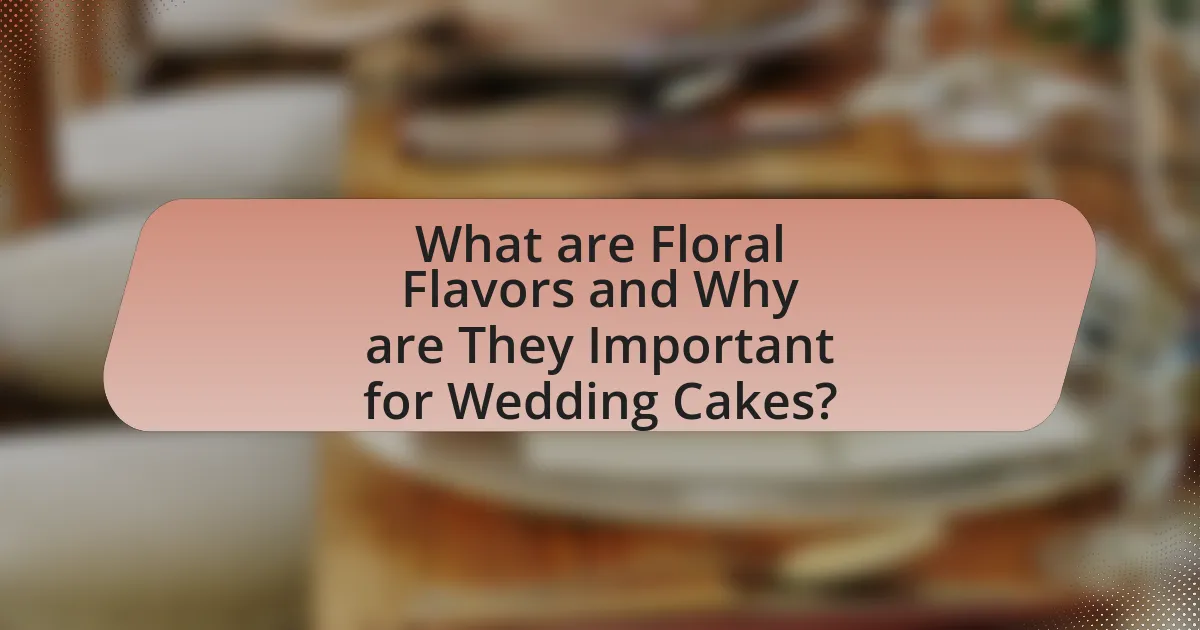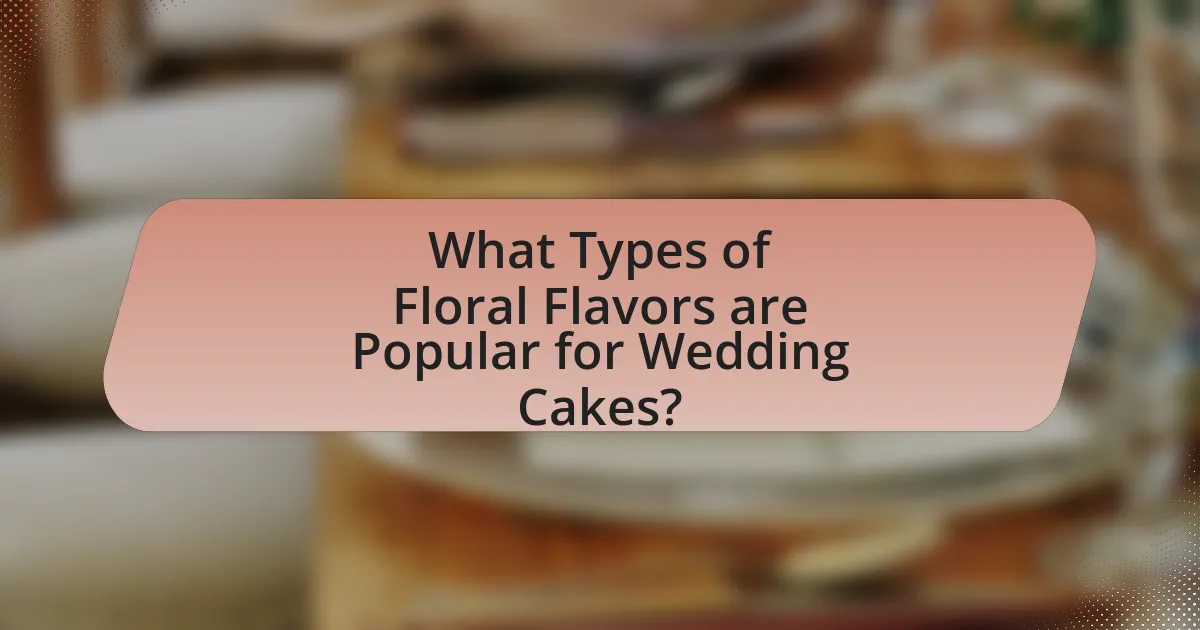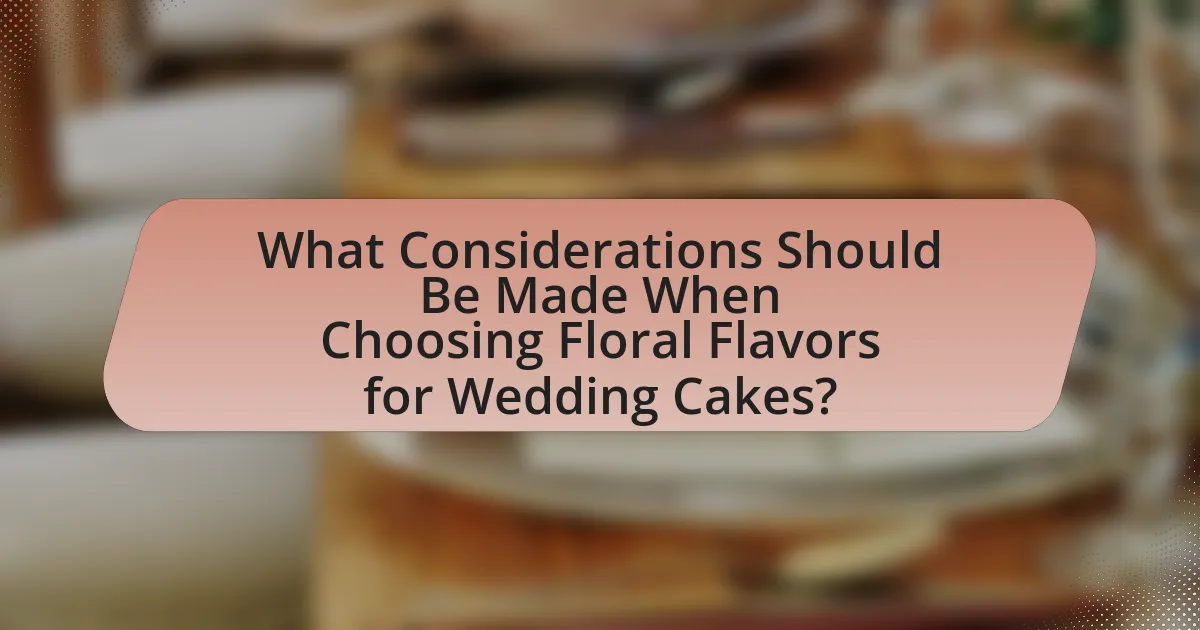Floral flavors, derived from edible flowers such as lavender, rose, and hibiscus, play a significant role in enhancing the taste and aesthetic appeal of wedding cakes. These flavors add complexity and depth, complementing traditional cake flavors while also contributing to the overall design and theme of the wedding. The article explores the various floral flavors commonly used, their cultural significance, and best practices for incorporating them into wedding cakes. Additionally, it addresses potential challenges, such as allergies and sourcing, while providing tips for achieving a balanced flavor profile.

What are Floral Flavors and Why are They Important for Wedding Cakes?
Floral flavors are taste profiles derived from edible flowers, such as lavender, rose, and hibiscus, that can be infused into wedding cakes to enhance their flavor and aesthetic appeal. These flavors are important for wedding cakes because they add a unique and sophisticated element that can complement the overall theme and ambiance of the wedding, making the cake not only a dessert but also a centerpiece. Additionally, floral flavors can evoke emotions and memories, contributing to the overall experience of the celebration.
How do floral flavors enhance the taste of wedding cakes?
Floral flavors enhance the taste of wedding cakes by adding complexity and depth to the overall flavor profile. These flavors, such as lavender, rose, and hibiscus, introduce subtle sweetness and aromatic notes that can balance richer ingredients like butter and chocolate. For instance, lavender can provide a calming, herbal quality, while rose adds a romantic and fragrant essence, making the cake more memorable. Studies in culinary arts indicate that floral notes can evoke emotions and enhance the sensory experience of eating, which is particularly significant during celebratory events like weddings.
What specific floral flavors are commonly used in wedding cakes?
Common floral flavors used in wedding cakes include lavender, rose, and hibiscus. Lavender provides a subtle, aromatic flavor that complements various cake types, while rose offers a sweet and fragrant profile, often used in buttercream or fondant. Hibiscus adds a tart and fruity note, enhancing the overall flavor complexity. These floral flavors are popular due to their unique tastes and the romantic associations they evoke, making them ideal for celebratory occasions like weddings.
How do floral flavors complement traditional cake flavors?
Floral flavors enhance traditional cake flavors by adding complexity and depth, creating a more nuanced taste experience. For instance, the delicate notes of lavender can balance the sweetness of vanilla, while rose can provide a refreshing contrast to rich chocolate. This interplay not only elevates the overall flavor profile but also introduces aromatic elements that engage the senses, making the cake more memorable. Studies in culinary arts highlight that incorporating floral notes can lead to a more sophisticated palate, appealing to modern tastes that favor unique and layered flavors.
What role do floral flavors play in wedding cake design?
Floral flavors play a significant role in wedding cake design by enhancing the cake’s aesthetic and flavor profile. These flavors, such as rose, lavender, and hibiscus, not only contribute to the overall taste but also align with the visual elements of the cake, creating a cohesive theme that resonates with the couple’s style and the wedding’s ambiance. For instance, rose flavoring can evoke romance, while lavender can impart a calming effect, making the cake a central piece that reflects the couple’s personality and the event’s mood. The incorporation of floral flavors also allows for unique combinations, elevating traditional cake recipes and offering guests a memorable tasting experience.
How can floral flavors influence the overall aesthetic of a wedding cake?
Floral flavors can significantly enhance the overall aesthetic of a wedding cake by adding unique tastes and visual appeal. Incorporating floral elements, such as lavender or rose, not only introduces distinct flavors but also allows for creative decoration options, such as edible flowers or floral-themed designs. This combination of taste and visual elements creates a cohesive and elegant presentation that aligns with the romantic theme of weddings. Studies have shown that cakes featuring floral flavors are often perceived as more sophisticated and appealing, thereby elevating the overall experience for guests.
What are the cultural significances of using floral flavors in wedding cakes?
Floral flavors in wedding cakes hold significant cultural meanings, often symbolizing love, purity, and new beginnings. In many cultures, flowers such as roses and lavender are associated with romance and beauty, making them ideal for celebrating the union of two individuals. For instance, in Western traditions, the use of rose flavor is linked to the idea of love and passion, while in Asian cultures, jasmine is often used to represent purity and devotion. These floral flavors not only enhance the aesthetic appeal of the cake but also convey deeper emotional connections and cultural values associated with marriage.

What Types of Floral Flavors are Popular for Wedding Cakes?
Popular floral flavors for wedding cakes include lavender, rose, and hibiscus. Lavender offers a subtle, aromatic taste that pairs well with vanilla and lemon, while rose provides a sweet and fragrant profile that complements various cake bases. Hibiscus, known for its tartness, adds a unique flavor that can enhance fruit-based cakes. These flavors are favored for their ability to evoke elegance and romance, making them ideal for weddings.
What are the most popular floral flavors used in wedding cakes?
The most popular floral flavors used in wedding cakes include lavender, rose, and hibiscus. Lavender offers a subtle, aromatic flavor that pairs well with vanilla and lemon, making it a favored choice for elegant cakes. Rose flavor, derived from rose petals, provides a sweet and fragrant profile that complements various cake types, particularly those with buttercream frosting. Hibiscus, known for its tart and fruity notes, adds a unique twist and vibrant color to wedding cakes, appealing to couples seeking a distinctive flavor. These floral flavors are often chosen for their aesthetic appeal and ability to evoke romance, making them ideal for wedding celebrations.
How does rose flavor differ from lavender flavor in cakes?
Rose flavor in cakes is characterized by its sweet, delicate, and slightly fruity notes, while lavender flavor is more herbal, floral, and aromatic with a hint of earthiness. The sweetness of rose enhances the overall flavor profile of cakes, making it suitable for lighter desserts, whereas lavender’s stronger, more complex flavor can dominate, often pairing well with richer ingredients like chocolate or honey. This distinction is supported by culinary practices where rose is commonly used in Middle Eastern desserts, while lavender is frequently found in French pastries, highlighting their unique flavor applications in baking.
What unique characteristics do hibiscus and elderflower bring to wedding cakes?
Hibiscus and elderflower contribute distinct characteristics to wedding cakes, enhancing both flavor and aesthetic appeal. Hibiscus imparts a tart, fruity flavor profile along with a vibrant red hue, making cakes visually striking and refreshing in taste. Elderflower, on the other hand, offers a delicate, floral sweetness that adds complexity and a subtle aromatic quality to the cake. These unique attributes not only elevate the overall flavor experience but also create an elegant presentation, appealing to couples seeking a sophisticated and memorable dessert for their special day.
How can bakers incorporate floral flavors into their wedding cake recipes?
Bakers can incorporate floral flavors into their wedding cake recipes by using edible flowers, floral extracts, and infused syrups. Edible flowers such as lavender, rose, and hibiscus can be added directly to the batter or used as decorations, providing both flavor and visual appeal. Floral extracts, like rose or orange blossom, can be mixed into the cake batter or frosting to enhance the floral notes. Additionally, bakers can create floral-infused syrups by steeping flowers in simple syrup, which can be brushed onto cake layers for added moisture and flavor. These methods not only elevate the taste but also align with the aesthetic of wedding cakes, making them more memorable.
What methods can be used to extract floral flavors for baking?
Methods to extract floral flavors for baking include infusion, distillation, and using essential oils. Infusion involves steeping edible flowers in liquids like water, milk, or sugar syrup to capture their flavors. Distillation, often used for more concentrated flavors, involves vaporizing the volatile compounds of flowers and then condensing them back into liquid form. Essential oils, derived from flowers through steam distillation or cold pressing, provide potent floral flavors and can be added directly to baking recipes. These methods are widely recognized in culinary practices for enhancing baked goods with floral notes.
How can bakers ensure the floral flavors are balanced in their cakes?
Bakers can ensure floral flavors are balanced in their cakes by carefully measuring and combining floral extracts, such as lavender or rose, with complementary ingredients. This approach allows bakers to achieve a harmonious flavor profile. For instance, using a ratio of one teaspoon of floral extract per cup of batter can prevent overpowering the cake’s overall taste. Additionally, incorporating acidic elements like lemon juice can enhance floral notes while maintaining balance. Research indicates that flavor perception is influenced by the interaction of different ingredients, supporting the need for precise measurements and combinations to achieve a well-rounded flavor.

What Considerations Should Be Made When Choosing Floral Flavors for Wedding Cakes?
When choosing floral flavors for wedding cakes, it is essential to consider the flavor profile, potential allergies, and seasonal availability of the flowers. The flavor profile should complement the overall cake design and other ingredients, ensuring a harmonious taste experience. Allergies are critical; some guests may have sensitivities to certain flowers, such as lavender or hibiscus, which can affect their enjoyment of the cake. Additionally, selecting flowers that are in season can enhance freshness and flavor, as well as reduce costs. For instance, roses and violets are popular choices that are often available during wedding seasons, providing both aesthetic appeal and taste.
How do seasonal availability and freshness affect floral flavor choices?
Seasonal availability and freshness significantly influence floral flavor choices by determining which flowers are at their peak quality and flavor profile at any given time. For instance, flowers like lavender and peonies are typically in season during spring and early summer, offering vibrant flavors that enhance wedding cakes. Freshness is crucial, as flowers harvested at their peak contain higher concentrations of essential oils and flavors, making them more aromatic and flavorful. Research indicates that the flavor intensity of edible flowers can diminish rapidly after harvest, emphasizing the importance of using seasonal and freshly picked blooms for optimal taste in culinary applications.
What are the best practices for sourcing edible flowers for cakes?
The best practices for sourcing edible flowers for cakes include purchasing from reputable suppliers, ensuring the flowers are labeled as edible, and confirming they are grown without harmful pesticides. Reputable suppliers often provide flowers specifically cultivated for culinary use, which guarantees safety and quality. Additionally, edible flowers such as pansies, nasturtiums, and violets are commonly used in cake decoration, and their safety can be verified through resources like the USDA or local agricultural extensions. Ensuring that flowers are free from pesticides is crucial, as many conventional flowers are treated with chemicals that are not safe for consumption.
How can bakers avoid using non-edible flowers in their creations?
Bakers can avoid using non-edible flowers by sourcing flowers specifically labeled as edible from reputable suppliers. Edible flowers include varieties such as pansies, nasturtiums, and violets, which are safe for consumption. To ensure safety, bakers should also verify that the flowers have not been treated with pesticides or chemicals harmful to humans. Research indicates that many common garden flowers are toxic, so consulting resources like the USDA’s list of edible flowers can provide guidance. By adhering to these practices, bakers can confidently incorporate safe floral elements into their creations.
What are the potential challenges of using floral flavors in wedding cakes?
The potential challenges of using floral flavors in wedding cakes include the risk of overpowering the cake’s overall taste, potential allergies among guests, and the difficulty in sourcing high-quality, edible flowers. Floral flavors can easily dominate other flavors if not balanced properly, leading to a cake that may not appeal to all palates. Additionally, certain individuals may have allergies to specific flowers, which could pose health risks during the event. Sourcing edible flowers that are safe and flavorful can also be challenging, as not all flowers are suitable for consumption, and quality can vary significantly.
How can bakers address allergies related to floral flavors?
Bakers can address allergies related to floral flavors by offering alternative flavor options and clearly labeling ingredients. This approach ensures that customers with allergies can make informed choices. For instance, using natural extracts from non-floral sources, such as vanilla or citrus, can provide flavor without triggering allergic reactions. Additionally, bakers should maintain strict cross-contamination protocols in their kitchens to prevent allergen exposure. According to the Food Allergy Research and Education organization, proper labeling and ingredient transparency are crucial for consumer safety, as they help individuals with allergies avoid potential health risks.
What are common misconceptions about floral flavors in baking?
Common misconceptions about floral flavors in baking include the belief that they are overly perfumed or artificial, and that they are only suitable for specific types of desserts. In reality, floral flavors, such as lavender, rose, and elderflower, can enhance the taste profile of various baked goods when used in moderation, providing subtle and complex notes rather than overpowering the dish. Additionally, many bakers assume that floral flavors are difficult to incorporate, but they can be easily integrated through extracts, infusions, or dried petals, allowing for versatility across different recipes.
What Tips Can Help in Successfully Using Floral Flavors for Wedding Cakes?
To successfully use floral flavors for wedding cakes, it is essential to select high-quality, edible flowers and incorporate them thoughtfully into the cake’s design and flavor profile. Using flowers like lavender, rose, or hibiscus can enhance the cake’s taste, but it is crucial to ensure that these flowers are safe for consumption and sourced from reputable suppliers. Additionally, balancing floral flavors with complementary ingredients, such as citrus or vanilla, can create a harmonious taste experience. For instance, lavender pairs well with lemon, while rose can be complemented by almond. Properly infusing floral flavors into frostings or syrups can also enhance the overall flavor without overwhelming the palate.
How can bakers experiment with floral flavors without overwhelming the cake?
Bakers can experiment with floral flavors without overwhelming the cake by using them in moderation and balancing them with complementary flavors. For instance, incorporating floral extracts or infusions, such as lavender or rose, in small quantities allows the floral notes to enhance the cake without dominating it. Additionally, pairing floral flavors with citrus or vanilla can create a harmonious blend that maintains the cake’s overall flavor profile. Research indicates that the human palate can detect floral notes at low concentrations, suggesting that subtlety is key in achieving a balanced taste.
What are some recommended pairings of floral flavors with other ingredients?
Recommended pairings of floral flavors with other ingredients include lavender with lemon, rose with pistachio, and hibiscus with berry flavors. Lavender enhances the brightness of lemon, creating a refreshing combination often used in desserts. Rose pairs well with the nutty flavor of pistachio, adding a luxurious touch to confections. Hibiscus, known for its tartness, complements various berry flavors, resulting in a vibrant and fruity profile. These pairings are commonly utilized in wedding cakes to create unique and memorable flavor experiences.
